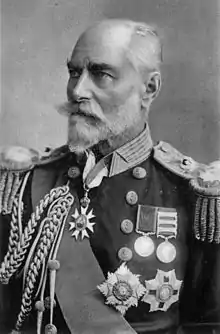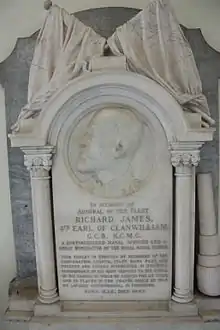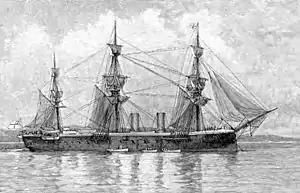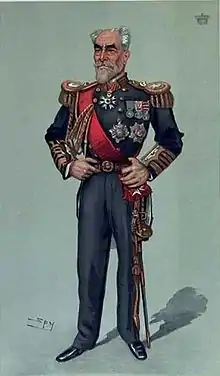Richard Meade, 4th Earl of Clanwilliam
Admiral of the Fleet Richard James Meade, 4th Earl of Clanwilliam GCB KCMG (3 October 1832 – 4 August 1907), styled Lord Gillford until 1879, was a Royal Navy officer. As a junior officer, he served at the Battle of Escape Creek and at the Battle of Fatshan Creek during the campaign against Chinese pirates. He also took part in the Battle of Canton, where he was severely wounded, during the Second Opium War.
The Earl of Clanwilliam | |
|---|---|
 The Earl of Clanwilliam | |
| Born | 3 October 1832 |
| Died | 4 August 1907 (aged 74) Badgemore House, Henley-on-Thames |
| Buried | |
| Allegiance | |
| Service/ | |
| Years of service | 1845-1902 |
| Rank | Admiral of the Fleet |
| Commands held | HMS Tribune HMS Hercules Steamship reserve at Portsmouth Flying Squadron North America and West Indies Station Portsmouth Command |
| Battles/wars | Crimean War Second Opium War |
| Awards | Knight Grand Cross of the Order of the Bath Knight Commander of the Order of St Michael and St George |

As a senior officer Meade went on to be commander of the Steamship reserve at Portsmouth, commander of the Flying Squadron and Commander-in-Chief, North America and West Indies Station. His last appointment was as Commander-in-Chief, Portsmouth.
Early career

Born the eldest son of Richard Meade, 3rd Earl of Clanwilliam and Elizabeth Meade (daughter of George Herbert, 11th Earl of Pembroke), Meade was educated at Eton College and joined the Royal Navy in November 1845.[1] Promoted to lieutenant on 15 September 1852, Meade was appointed to the frigate HMS Impérieuse in which he served in the Baltic Sea during the Crimean War.[2] He transferred to the frigate HMS Raleigh in September 1856 bound for China and, although the ship was wrecked near Hong Kong, all the crew survived.[2] He served under Commodore Charles Elliot at the Battle of Escape Creek in May 1857 and under Commodore Henry Keppel at the Battle of Fatshan Creek in June 1857 during the campaign against Chinese pirates.[2]
Meade transferred to the second-rate HMS Calcutta, flagship of the Commander-in-Chief, East Indies Station, in August 1857 and, having landed with the naval brigade, took part in the Battle of Canton in December 1857 during the Second Opium War: he was severely wounded in the left arm by a bullet fired from a gingal.[3] He was mentioned in dispatches, promoted to commander on 26 February 1858[4] and transferred to the sloop HMS Hornet later that month.[3]
Promoted to captain on 22 July 1859, Meade became commanding officer of the corvette HMS Tribune on the Pacific Station in 1862 and commanding officer of the battleship HMS Hercules in the Channel Fleet in 1868.[3] He was appointed an aide-de-camp to the Queen and became commanding officer of the steamship reserve at Portsmouth in 1872.[3]
Senior command

Meade became Junior Naval Lord in the Second Disraeli ministry in May 1874 and, having been promoted to rear admiral on 31 December 1876,[5] was appointed a Companion of the Order of the Bath on 2 June 1877.[6] He succeeded to his father's titles in October 1879 and was elevated to Second Naval Lord in the same ministry in December 1879 where he sat until the Government fell in May 1880.[3] He became commander of the Flying Squadron, with his flag in the frigate HMS Inconstant in August 1880, and was promoted to vice-admiral on 26 July 1881.[7] However, while the squadron was in port at Sydney on 22 July, he "suffered a fainting fit, the attack resembling paralysis."[8] The effects were severe enough to delay the departure of the squadron, planned for 24 July, to 10 August.[9][10]

Meade was appointed a Knight Commander of the Order of St Michael and St George on 3 March 1882[11] and became Commander-in-Chief, North America and West Indies Station, with his flag in the central battery ship HMS Bellerophon, in August 1885.[3] Promoted to full admiral on 22 June 1886,[12] he was advanced to Knight Commander of the Order of the Bath on 21 June 1887.[13]
Meade was appointed a commissioner of the Royal Patriotic Fund Corporation in 1888 and became Commander-in-Chief, Portsmouth in June 1891.[3] Promoted to Admiral of the Fleet on 20 February 1895,[14] he was advanced to Knight Grand Cross of the Order of the Bath on 25 May 1895.[15]
He retired in October 1902[16] and died at his home, Badgemore House, near Henley-on-Thames from pneumonia on 4 August 1907.[3] He was buried at the family vault at Wilton, Wiltshire and his titles passed to his eldest surviving son, Arthur.[3]
Memorials
A memorial to Meade stands in the entrance lobby of the chapel at the Old Royal Naval College in Greenwich, south-east London.[17]
Family
On 17 June 1867 Meade married Elizabeth Kennedy (the eldest daughter of Sir Arthur Kennedy); they had four sons and four daughters.[3] A younger son was Admiral Herbert Meade, who adopted the surname Meade-Fetherstonhaugh.[18]
References
- "Meade, Richard James, fourth earl of Clanwilliam (1832–1907)". Oxford Dictionary of National Biography (online ed.). Oxford University Press. doi:10.1093/ref:odnb/34968. (Subscription or UK public library membership required.)
- Heathcote, p. 170
- Heathcote, p. 171
- "No. 22104". The London Gazette. 26 February 1858. p. 1028.
- "No. 24400". The London Gazette. 2 January 1877. p. 5.
- "No. 24467". The London Gazette. 2 June 1877. p. 3497.
- "No. 25000". The London Gazette. 29 July 1881. p. 3740.
- "Illness of the Earl of Clanwilliam". The Argus. Melbourne. 23 July 1881. p. 9. Retrieved 1 January 2020.
- "The Detached Squadron". The Sydney Morning Herald. Sydney. 9 August 1881. p. 5. Retrieved 1 January 2020.
- "The Detached Squadron". The Sydney Morning Herald. Sydney. 11 August 1881. p. 5. Retrieved 1 January 2020.
- "No. 25080". The London Gazette. 3 March 1882. p. 976.
- "No. 25600". The London Gazette. 25 June 1886. p. 3033.
- "No. 25712". The London Gazette. 21 June 1887. p. 3361.
- "No. 26601". The London Gazette. 22 February 1895. p. 1066.
- "No. 26628". The London Gazette. 25 May 1895. p. 3079.
- "No. 27483". The London Gazette. 17 October 1902. p. 6568.
- "Admiral of the Fleet Richard James - ORNC Chapel, Greenwich, London, UK". Way marking. Retrieved 22 July 2015.
- "Herbert Mead". Dreadnought project. Retrieved 20 January 2019.
Sources
- Heathcote, Tony (2002). The British Admirals of the Fleet 1734 – 1995. Pen & Sword Ltd. ISBN 0-85052-835-6.
External links
| Wikimedia Commons has media related to Richard Meade, 4th Earl of Clanwilliam. |
- Laughton, Leonard George Carr (1912). . Dictionary of National Biography (2nd supplement). London: Smith, Elder & Co.
- Hansard 1803–2005: contributions in Parliament by The Earl of Clanwilliam
- The Dreadnought Project: Richard Meade, 4th Earl of Clanwilliam
- William Loney Career History
| Military offices | ||
|---|---|---|
| Preceded by Sir Beauchamp Seymour |
Junior Naval Lord 1874–1879 |
Succeeded by Sir John Commerell |
| Preceded by Sir Arthur Hood |
Second Naval Lord 1879–1880 |
Succeeded by Lord John Hay |
| Preceded by Sir John Commerell |
Commander-in-Chief, North America and West Indies Station 1885–1886 |
Succeeded by Sir Algernon Lyons |
| Preceded by Sir John Commerell |
Commander-in-Chief, Portsmouth 1891–1894 |
Succeeded by Sir Nowell Salmon |
| Peerage of Ireland | ||
| Preceded by Richard Meade |
Earl of Clanwilliam 1879–1909 |
Succeeded by Arthur Meade |